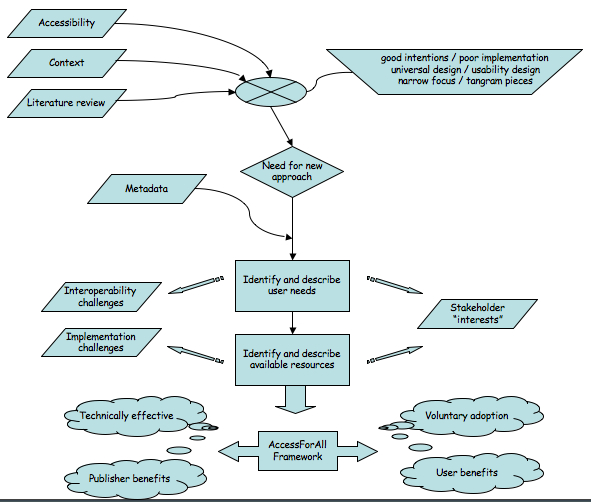Chapter
12: Conclusion
Introduction
The Preamble (Chapter
1) defines accessibility as a
successful matching of information and communications to
a user's needs and preferences to enable the user to interact
with and perceive the intellectual content of the information
or communications. The Introduction (Chapter
2) says:
The first decade of international effort to make
the Web accessible has not achieved its goal and a different
approach is needed. In order to be more inclusive, the
Web needs published resources to be described to enable
their tailoring to the needs and preferences of individual
users. Resources need to be continuously improvable
according to a wide range of needs and preferences. Thus
there is a need for management of resources that can be
achieved with metadata. The specification of metadata to
achieve such a goal is complex given the requirements,
themselves not previously determined.
Metadata is a tool for supporting the management and descriptions
of resources to achieve these ambitious goals. Designing
the metadata specifications is a complex task as that task
necessarily precedes its use and thus verification of its
requirements.
The subsequent chapters report on:
- the last ten years' efforts
to define disability and thus accessibility (Chapter
3);
- the development of universal accessibility techniques
for making the content of the emerging Web accessible (Chapter
4);
- what success
or otherwise has resulted from the universal accessibility
approach and responses to this state (Chapter
5);
- an understanding and definiton of metadata and its
potential role in a networked, digital world (Chapter
6);
- early investigations and efforts in the use and likely
availability of metadata to support accessibility or resources
(Chapter 7);
- a new use of metadata to describe individual user's needs
and preferences with respect to resources in ways that are
useful to people with special needs for effective perception
of their content (Chapter 8);
- a more traditional use of metadata to describe resources
in ways that are useful to people with special needs for
effective perception of the intellectual content of the
resource (Chapter 9);
- an extended use of metadata to provide a means
of managing digital resource components for matching of compositions
of those resources in ways that were effective for individual
users (Chapter 10);
- the definition of effective interoperability and the need
for technical interoperability of AccessForAll metadata if
its implementation is to become a reality (Chapter
11), and
then
- this conclusion.
Final discussion
In "Accessibility, usability and adaptability: responding
to Dublin Core Profiles of Needs and Preferences", the
authors assert:
.. the newly emerging IMS and Dublin Core adaptability
and accessibility standards and the proposed profiles of
needs and preferences (PNP) is set to have a profound impact
on the way we view the creation of digital content as well
as the way it is presented to us. (Green
S, ???, p. 18)
This thesis has worked its way through a maze of issues to
justify a simple contention stated at the beginning:
Considering the problems of accessibility,
the context in which the problem occurs, and the available
solutions, it has been necessary to define a more comprehensive
framework in which the available parts can function, taking
better advantage of the emerging technologies, without compromising
either the interests of stakeholders or existing efforts,
to achieve a better outcome for users and publishers.
The thesis has followed the structure proposed in the Figure
???:
It has been shown that given the newer technologies and techniques,
including what is known as Web 2.0 technologies and metadata,
it is possible to be more comprehensive in the approach to
accessibility without compromising hard-won efforts and that
there is a receptive community that are willing to work with
the new framework. The thesis is the first and only document
to comprehensively explain this work and show its potential
to justify the claims of Green et all and to support future
work.
Future work
events and places, FLUID, distributed discovery, ..... further
work includes work on how to discover the extra pieces - using
FRBR??
Back to beginning
-->
 This work is licensed under a Creative Commons Attribution-Noncommercial-Share Alike 2.5 Australia License.
© 2008 Liddy Nevile
This work is licensed under a Creative Commons Attribution-Noncommercial-Share Alike 2.5 Australia License.
© 2008 Liddy Nevile